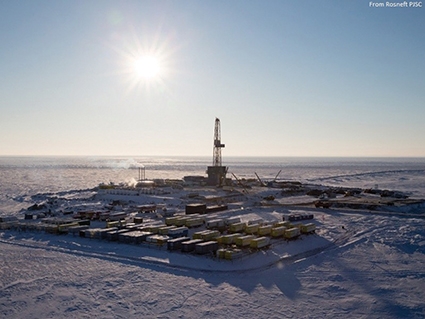Russia Drills the Northern-Most Well in the World
President Putin launched via videoconference the exploratory drilling of the northern-most Russian well, Central Olginskaya-1. Oil reserves there are estimated at 9.5 billion tons, with huge additional gas reserves.
Getting to the peninsula of Hara Tumus is not easy. First by plane to Krasnoyarsk or Norilsk, then by local airlines to the village of Khatanga, and then the last 300 kilometers to the Khatyngsky Bay area by helicopter. There is no housing and no civilization. Reindeer breeders with herds appear there only during the short northern summer.
The well is located 70 meters from the coast, and is to be drilled at an angle of 5 kilometers under the very waters of the bay.
The Head of State personally gave the head of Rosneft the go-ahead to start the work. Almost immediately, the weather turned bad in the drilling area. Despite this, drilling began, making it the first deposit well in the Eastern Arctic. The drill has already passed 40 meters, and scientific data is expected to be received by autumn, while preparations for the start of work are to fall in the most difficult and longest season here - winter.
According to some estimates, by 2050, production on the Arctic shelf will account for up to one-third of all Russian oil production.
Mastering the resources and even any talk about the mining of minerals in the Arctic is preceded by an extensive scientific study. The research station is 16 km from the drilling site. The veteran of many expeditions of the Institute of the Arctic and Antarctic, Dog Archie, who is well known to polar explorers, has been brought to the base, where, he says, he feels quite at home.
24 people will be in the camp and 20 more in the field expedition on an ice floe of 80 kilometers. If the weather goes bad, scientists from the camp can be evacuated only by helicopter.
Expedition ‘Kara-summer-2016’ was allowed to conduct unique experiments and for the first time in Russia, technology for changing the trajectory of the drift of large icebergs was tested, and as a result, an iceberg was towed with a mass of over one million tons. As emphasized in Rosneft, preservation of the unique Arctic ecosystem will be given the utmost attention.
One of the specific results already achieved, which the scientific community can use, is the restoration of the system of meteorological observations in the Arctic. However, as the polar explorers say, when someone enters this region, even a large state company, it becomes an event, often cardinally changing the life of an individual and the whole team.
"We solve complex problems of interaction between the natural environment and man, because the ice is a carrier platform which absorbs all the information of human activity,” said Evgeny Makarov, head of the Khatynga-Zima expedition. “We study ice as an environment for life because it is a memory of planet Earth and displays all the processes that occur in the air and water environment".
Dimitri Dolaberidze











